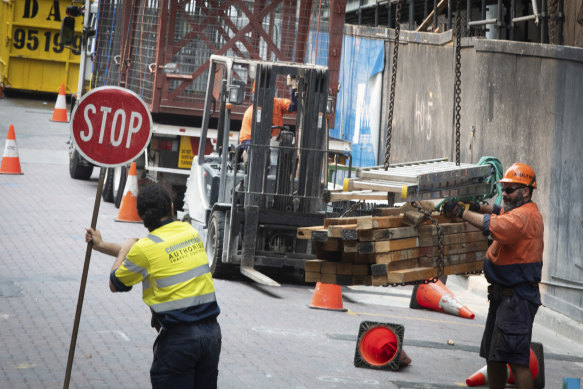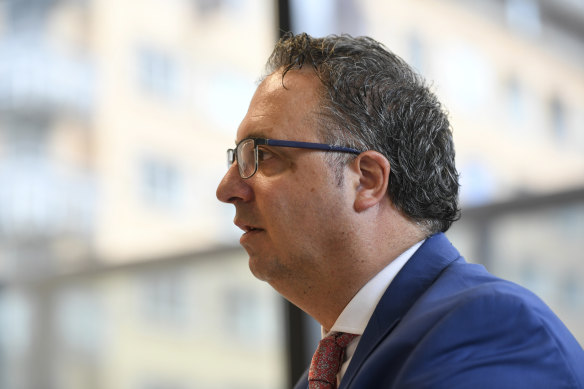This was published 2 years ago
Victoria facing shortage of almost 400,000 workers by 2025
By Josh Gordon
Victoria is facing a shortage of almost 400,000 workers within three years, amid warnings the lowest unemployment for almost 50 years and soaring job vacancies could soon act as a handbrake on the state economy.
Ahead of next month’s federal jobs summit, a report by Victoria’s new Skills Authority has suggested the state is in danger of not having enough suitable workers across a range of key industries.

The report says Victoria needs to find thousands of construction workers.Credit: Renee Nowytarger
The report warns Victoria is facing a looming shortage of about 373,000 workers by 2025.
That includes 65,000 health and aged and disability care workers, 90,000 service sector workers, 41,000 teaching staff, 34,000 construction workers and 64,000 financial services and IT professionals.
It warned that the difference between the skills of the workers currently available, and those that will be needed by businesses to cope with new industries and technologies would be a major problem in the coming years.
“Victoria’s labour market is currently experiencing a high-level mismatch, with employers citing a lack of skills as a reason for recruitment difficulties,” the report said.
“There are both labour and skills shortages across sections of the economy,” the report said.
“Regional areas are feeling these workforce challenges most acutely.”
It found that Melbourne will need an extra 290,400 workers by 2025. But other parts of the state are also being squeezed, with regional areas facing a shortage of 82,000 workers by 2025. Gippsland, for example, is facing a shortage of 12,900 workers. The surf coast area is expected to be short by about 18,300 workers, while the Goulburn area to the north-east will need an extra 8000.
“Changing demographics are putting pressure on local services, while skills shortages can hamper local industry growth,” it said.
The report said regional Victoria represented more than 20 per cent of the state’s total workforce, with almost 75 per cent of agriculture, forestry and fishing, 44 per cent of mining and 26 per cent of construction employment based in the regions.
It follows figures from the Bureau of Statistics last week showing Victoria’s unemployment rate dropped to just 3.1 per cent in July, the lowest since 1974.
Other figures from the bureau show there were 120,100 vacant positions across the state in May. That means there is now the equivalent to just over one unemployed person for every vacant job, compared with almost three for every vacant position three years earlier.
Business groups and unions have singled a shortage of skilled and unskilled workers as a key problem ahead of the summit, with acute shortages in health, teaching, construction, hospitality and agriculture.

Victorian Chamber of Commerce and Industry chief executive Paul Guerra says there are now more jobs than there are workers.Credit: Penny Stephens
Victorian Chamber of Commerce and Industry chief executive Paul Guerra said Victoria was in a situation where it had more jobs available than people.
“It doesn’t matter whether you’re skilled or unskilled, there are jobs if you’re working,” he said. “It’s across the board – across regional Victoria, and metropolitan Victoria, it’s all the same. They just can’t get enough people. You see it in the hospitality sector you see it in the retail sector. There are businesses that can’t open because they don’t have staff.”
The report also suggest a key solution to Victoria’s jobs woes would be to increase workforce participation rates, particularly among women. About 62 per cent of women are counted as in the labour market, compared with 72 per cent of men.
But business groups are also calling for immediate efforts to ramp up migration to tackle skills shortages. Business Council of Australia chief executive Jennifer Westacott said Australia needed to move away from a short-term, ad hoc migration system, to a long-term planned migration program.
She said there needed to be a “catchup boost” to the permanent migration program to tackle skills shortages, with at least two-thirds of places set aside for skilled workers.
Training Minister Gayle Tierney said skills shortages linked to low unemployment was “a good problem to have”, saying the government was ramping up efforts to boost skills to meet future demand for workers.
The federal government has signalled that it will lift Australia’s permanent migration intake to a level between 180,000 to 200,000, up from 160,000 currently.
Premier Daniel Andrews has also backed lifting the migration intake.
“I can say that with a sense of clarity because we’re investing very strongly in our domestic training,” he said earlier this month.
The Morning Edition newsletter is our guide to the day’s most important and interesting stories, analysis and insights. Sign up here.